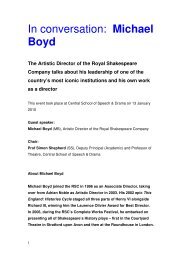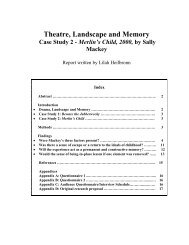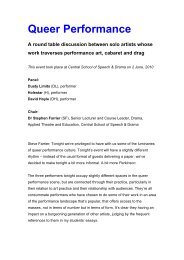the puppet as a figure of the other final P PIRIS 2013 - Central ...
the puppet as a figure of the other final P PIRIS 2013 - Central ...
the puppet as a figure of the other final P PIRIS 2013 - Central ...
- No tags were found...
Create successful ePaper yourself
Turn your PDF publications into a flip-book with our unique Google optimized e-Paper software.
dimension <strong>of</strong> separateness, interiority, secrecy or what Levin<strong>as</strong> calls “alterity” thatescapes my comprehension.’ (Critchley 2008: 26). The concept <strong>of</strong> alterity is addressedduring <strong>the</strong> research to investigate <strong>the</strong> relation between <strong>the</strong> performer and <strong>the</strong> <strong>puppet</strong>.A discussion about <strong>the</strong> O<strong>the</strong>r is necessary before fur<strong>the</strong>r investigating <strong>the</strong> <strong>puppet</strong><strong>as</strong> a <strong>figure</strong> <strong>of</strong> <strong>the</strong> O<strong>the</strong>r. As D<strong>as</strong>tur suggests, cl<strong>as</strong>sic philosophy does not consider <strong>the</strong>question <strong>of</strong> <strong>the</strong> O<strong>the</strong>r <strong>as</strong> an issue. The question is resolved through analogy. ‘Because Iexperience within myself <strong>the</strong> <strong>as</strong>sociation between a body and a consciousness, anyliving body similar to mine can be considered <strong>as</strong> <strong>as</strong>sociated with a consciousnessdifferent from mine.’ (D<strong>as</strong>tur 2006: 3) The O<strong>the</strong>r is not solely given to me <strong>as</strong> a body, <strong>as</strong>an object in <strong>the</strong> world, because if that were <strong>the</strong> c<strong>as</strong>e, it would not be possible to see this‘object’ <strong>as</strong> a subject similar to myself. D<strong>as</strong>tur explains that ‘<strong>the</strong> O<strong>the</strong>r is immediatelygiven to me <strong>as</strong> a subject, <strong>as</strong> a “self” ’ (D<strong>as</strong>tur 2006: 4). The experience <strong>of</strong> <strong>the</strong> O<strong>the</strong>r isdistinct from any o<strong>the</strong>r sorts <strong>of</strong> experiences, precisely because <strong>the</strong> O<strong>the</strong>r questions <strong>the</strong>opposition <strong>of</strong> <strong>the</strong> subject and <strong>the</strong> object.For Sartre <strong>the</strong> subject does not constitute <strong>the</strong> O<strong>the</strong>r. He encounters him. Theupsurge <strong>of</strong> <strong>the</strong> O<strong>the</strong>r in his world operates a decentralisation <strong>of</strong> <strong>the</strong> position <strong>of</strong> <strong>the</strong>subject. The objects <strong>of</strong> <strong>the</strong> world are no longer organised around him. In Being andNothingness (2007), Sartre describes <strong>the</strong> experience <strong>of</strong> walking in a park. As he walks,he sees a man p<strong>as</strong>sing at some distance from him. ‘I see this man; I apprehend him <strong>as</strong> anobject and at <strong>the</strong> same time <strong>as</strong> a man. What does this signify? What do I mean when I<strong>as</strong>sert that this object is a man?’ (Sartre 2007: 278) Sartre argues <strong>as</strong> follows. ‘If I wereto think <strong>of</strong> him <strong>as</strong> being only a doll, I should apply to him <strong>the</strong> category which Iordinarily use to group temporal-spatial “things”.’ (Sartre 2007: 278) In that c<strong>as</strong>e <strong>the</strong>reis no new relation between <strong>the</strong> subject and <strong>the</strong> objects <strong>of</strong> <strong>the</strong> world if <strong>the</strong> man isapprehended <strong>as</strong> an object. However, ‘perceiving him <strong>as</strong> a man …, it is to register an32






